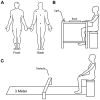Remnants of Cardinal Symptoms of Parkinson's Disease, Not Dyskinesia, Are Problematic for Dyskinetic Patients Performing Activities of Daily Living
- PMID: 30967832
- PMCID: PMC6440171
- DOI: 10.3389/fneur.2019.00256
Remnants of Cardinal Symptoms of Parkinson's Disease, Not Dyskinesia, Are Problematic for Dyskinetic Patients Performing Activities of Daily Living
Abstract
Introduction: The impact of levodopa-induced dyskinesia (LID) on the daily lives of patients with Parkinson's disease (PD) remains to be determined. Furthermore, evidence suggests that cardinal motor symptoms of PD may coexist with LID, but their impact on activities of daily living (ADL) relative to LID is not known. This cross-sectional study aimed at determining the effect of LID and cardinal motor symptoms of PD on ADL in patients who were experiencing peak-dose choreic-type LID. Method: One hundred and twenty-one patients diagnosed with PD known to experience choreic-type LID were recruited for the study. Patients were asked to perform a set of ADL. Levels of LID, tremor, bradykinesia, and freezing of gait (FoG) were measured using 17 inertial sensors design to capture full body movements, while rigidity, and postural instability were assessed using clinical evaluations. Cognition was also assessed using the mini-mental state examination. Success criteria were set for each ADL using the time needed to perform the task and errors measured in 69 age-gender-matched healthy controls. Binary logistic regressions were used to identify symptoms influencing success or failure for each activity. Receiver operating characteristic curves were computed on each significant symptom, and Youden indexes were calculated to determine the critical level of symptomatology at which the performance significantly changed. Results: Results show that 97.7% of patients who presented with LID during the experiment also presented with at least one cardinal motor symptom. On average, patients took more time and did more errors during ADL. Multivariate analyses revealed that for the great majority of ADL, LID were not associated with worsening of performance; however, postural instability, tremor, rigidity, and cognitive decline significantly decreased the odds of success. Conclusions: Residual symptoms of PD, such as tremor, rigidity, and postural instability still present at peak-dose were more problematic than LID in the performance of ADL for patients experiencing slight-to-moderate LID. We also found that cognitive decline was associated with decreased performance in certain tasks. Therefore, a strategy using lower doses of medication to manage LID may be counterproductive since it would not address most of these symptoms already present in patients.
Keywords: Parkinson disease; activities of daily living; cardinal symptoms; levodopa-induced dyskinesia; motor performance.
Figures




References
LinkOut - more resources
Full Text Sources
Molecular Biology Databases

